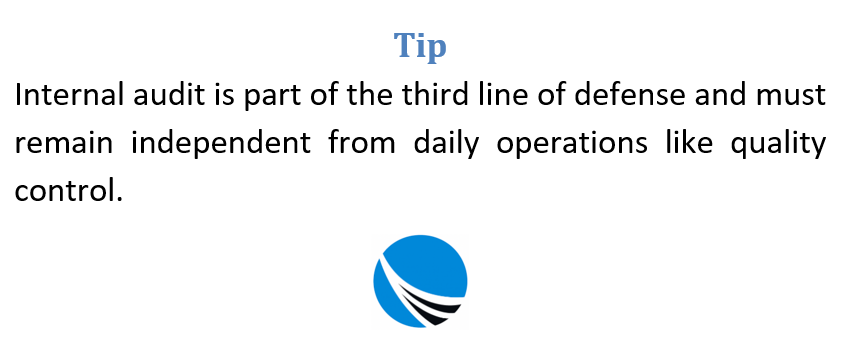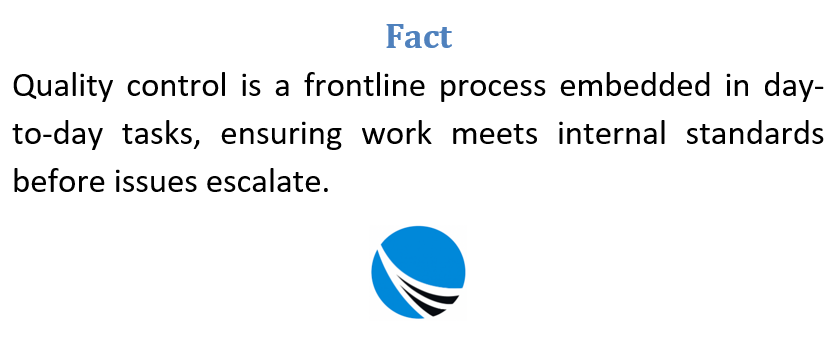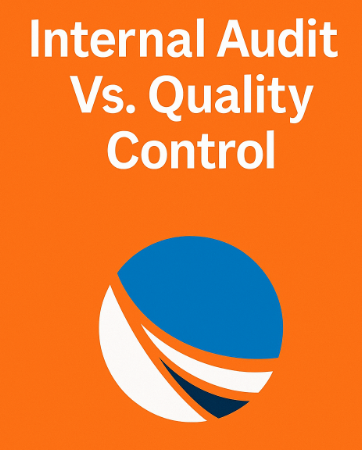When it comes to maintaining integrity and performance within an organization—especially in highly regulated environments like financial institutions—there are two essential functions often mistaken for one another: internal audit and quality control. While both play crucial roles in supporting a company’s operational soundness, their purposes, methods, and oversight responsibilities are very different. Confusing the two can create structural gaps or even conflict of interest in risk governance. Let’s explore each of these functions and clarify how they diverge in purpose and practice.

The Purpose of Internal Audit
Internal audit serves as a mechanism for objective assurance and independent insight. It’s not just another layer of operational review—it is, fundamentally, an internal advisory service focused on risk, controls, and governance. The goal is to evaluate how well various parts of an organization are functioning and to recommend ways to improve them.
This function doesn’t limit itself to financials or compliance alone. Auditors look at every aspect of an organization, including IT systems, procurement processes, HR policies, and operational activities. Their main mission is to verify whether existing internal controls are functioning as intended and whether risks are being properly managed. In this way, internal audit provides a protective lens, examining both the health of existing frameworks and areas of exposure.
Because of its independent nature, the internal audit function is usually designed to report directly to a board-level audit committee or equivalent oversight body, not operational management. This organizational independence allows internal auditors to assess issues without bias and report findings without conflict of interest.

The Role of Quality Control
Unlike internal audit, quality control is an operational function that resides within the regular management structure. It’s designed to ensure that a company’s products or services meet predefined standards. In practical terms, quality control is about prevention and correction—it works to identify problems early and intervene before they escalate into costly errors or customer dissatisfaction.
Quality control involves detailed checks, testing, and monitoring. It can be as simple as verifying that all client documents are correctly completed before account setup, or as complex as inspecting manufacturing processes for defects. It may occur daily, weekly, or even in real-time, depending on the process it supports.
Importantly, quality control isn’t necessarily impartial—it’s part of the daily work environment and typically carried out by staff who have a stake in the outcome. In short, it’s about doing the job right the first time and fixing it quickly when it isn’t.
Why Distinguishing the Two Matters
Though both internal audit and quality control aim to support organizational improvement, the difference lies in how and why they intervene.
- Quality control is embedded in the operational process; it’s a frontline activity designed to prevent errors in real time.
- Internal audit is retrospective and advisory; it looks at the bigger picture, identifying systemic risks and advising on better frameworks for decision-making.
Mixing the two creates complications. For instance, if internal auditors begin performing daily report checks or operational verifications (normally quality control duties), they may become part of the process they’re supposed to independently evaluate. This compromises their objectivity and dilutes the purpose of having an independent audit function.
The Three Lines Model: A Framework for Clarity
To better understand how these roles fit within an organizational context, many organizations refer to the “Three Lines Model,” a widely adopted framework for risk management.
First Line: This is where operations live. Employees here manage risks directly through the execution of day-to-day tasks. They deliver services, follow procedures, and take responsibility for performance. This is where quality control typically resides—within business units managing real-time output.
Second Line: Here, oversight functions such as compliance, risk management, and internal control monitoring are positioned. They provide guidance and develop frameworks but are still part of the management structure. Quality assurance and control teams can also be part of this line, offering structured monitoring but not independent review.
Third Line: The internal audit function sits here. It operates with full independence from management, offering an external perspective on how well the first two lines are functioning. It does not own or manage any processes but reviews how risks are being controlled and provides assurance to the board or audit committee.
By following this model, organizations ensure a clean separation between operational work and oversight, thereby reducing conflict of interest and enhancing the integrity of reviews.
Common Misunderstandings and Their Consequences
Despite the clarity of roles in theory, in practice, the lines can blur. A frequent issue arises when internal auditors step in to perform monitoring tasks usually associated with quality control. This may happen out of necessity—perhaps the company lacks a dedicated quality control function—or due to a lack of clarity in responsibilities.
For example, an internal audit team may routinely check reports related to dormant accounts, unbalanced ledgers, or incomplete customer files. While this seems helpful, if done on a continuous basis, these checks shift from being occasional audit procedures to ongoing quality control work.
This shift matters because it can:
- Jeopardize audit independence,
- Overextend internal audit resources,
- Lead to audit gaps in areas not being reviewed due to time constraints,
- And result in missed systemic risks, as auditors get bogged down in tactical tasks.
Moreover, if internal auditors assume quality control tasks, they may inadvertently fail to include quality processes in their audit plan, believing that they’ve “covered it” by doing the work. This creates a blind spot in overall risk assessment.
Clarifying Boundaries and Building Synergy
So how can organizations draw clear lines between internal audit and quality control while ensuring both functions work effectively?
- Define Responsibilities Clearly: Job descriptions, process manuals, and audit charters should clearly outline where audit ends and quality control begins. When roles are defined ambiguously, gaps and overlaps are inevitable.
- Conduct Annual Role Reviews: Regularly assess how internal audit and quality control interact. Are auditors doing things outside their scope? Are quality control activities being executed consistently?
- Train Staff Across Functions: Both auditors and operational staff should understand the differences in their roles. Cross-training helps eliminate misconceptions and reinforces the importance of maintaining functional boundaries.
- Avoid Using Audit as a Stopgap: If there’s a quality control gap, the solution is to strengthen that second line of defense—not ask the auditors to do more. Internal audit should report gaps to leadership, not fill them by default.
- Include Quality Control in Audit Plans: Rather than performing quality checks, auditors should assess how well the quality control process works. This keeps them independent while still offering value in improving those systems.
Quality Control and Internal Audit in Harmony
While these functions must remain separate, they should also collaborate in a way that enhances the organization’s overall risk posture.
For example, an internal audit can assess whether a quality control system is catching enough errors early, whether root causes are being addressed, and whether data is being used effectively to inform operational decisions. Similarly, a strong quality control team can reduce the number of issues that arise during formal audits, making the audit process smoother and more focused.
This type of coordination leads to a feedback loop—quality control improves daily processes, and internal audit helps improve the quality control system. Both functions strengthen the organization’s capacity to operate smoothly and respond to risk proactively.

Final Thoughts
Confusing internal audit with quality control can lead to inefficiencies, missed risks, and compromised independence. While they share a broad goal of helping an organization perform better, their tools, timing, and positioning within the organization are fundamentally different.
Internal audit should maintain its independence, act as the final line of defense, and focus on providing assurance at the strategic level. Quality control should remain embedded in the operational heartbeat of the organization, identifying and fixing issues as they emerge.
By understanding the difference, clearly defining roles, and fostering mutual respect between these two functions, organizations can create a risk and control environment that is robust, agile, and fit for the future.
Frequently Asked Questions
What does internal audit really focus on?
Internal audit is all about stepping back to see the bigger picture. It looks at how well a company is managing risks, following rules, and making sure everything is running smoothly. Auditors give independent feedback to improve how the organization operates—not just fix day-to-day errors.
How is quality control different from internal audit?
Quality control works in the moment. It focuses on catching mistakes during everyday work—like making sure forms are filled out correctly or processes are followed step-by-step. Unlike internal audit, it’s done by staff involved in the process and isn’t independent.
Why is it risky to mix up internal audit and quality control?
If internal auditors start doing quality control work, they lose their independence. That means they can’t provide objective assurance, and their time may be spent fixing problems instead of evaluating bigger risks. It blurs the lines and can create blind spots in oversight.
Read More: 6 Must-Know Auditor Experiences and How to Handle Them
Where do these functions fit in the Three Lines Model?
Quality control fits into the first and second lines of defense—these are operational and management oversight roles. Internal audit is the third line, completely independent, giving assurance to leadership and the board on how well the first two lines are working.
Can internal audit review quality control?
Yes—but not by doing the work itself. Internal audit should step back and assess how effective the quality control process is. This helps strengthen the organization’s risk management without stepping into operational duties.
How can organizations avoid confusion between the two?
By clearly defining each role, training teams, and regularly reviewing responsibilities. Internal audit should stay focused on oversight, while quality control should remain part of everyday operations. When both teams understand their place, the whole company benefits.

